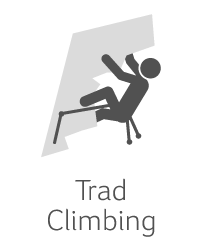
Day 2 of supporting Dan McKinlay delivering a broad leading development workshop to 8 climbers with a broad range of experiences and backgrounds. The day started with coverage of how to rig a self-abseil. I then worked with 2 groups and fielded a number of questions about building anchors and suitability. This drew out some significant distinctions in gear placement and rating and clarification that gear is only weighted and thus tested in a fall, but anchors are tested and weighted so the quality and redundancy must be much higher. I then moved on to working with Sasha and Hannah, Sasha climbs 7b+ sport and Hannah 8a, so both are competent indoor and sport climbers. The key activity to develop them was placing under duress when placing gear using a ghost rope. Due to a lack of ropes this moved to just top-roping. Whilst both responded well to this in theory it is hard to simulate duress without experiencing duress which wasn't appropriate for safety reasons and furthermore, I had not had the opportunity to rate Hannah's gear. They both moved through Agony crack with relative ease after I'd rigged it so we looked at a harder route in Exit Stage left to test both placement and duress. This did provide learning for Hannah as she came off relatively low without having placed much gear. For her the grade "comparison" of E1 to 6a provided a moment of reflection. We also used the routes to highlight that ledges are the ground for the climber and therefore consideration for gear needs to be about more than just placing gear to protect a ground fall. By this point, both climbers were keen to get leads in so we identified new routes around their onsight level (but likely well within their climbing ability) with Hannah leading Centre Stage. Her gear placement was limited in the protection of the crux move, especially given the ledge beneath which we discussed. We then moved onto Sasha's lead and discussed setting up directional anchors and not simply spotting the gear immediately ahead. Finally Hannah got her final lead in and usefully there was a rocking block at the top, usefully highlighting the dangers of not testing blocks before placing a cam. All in all gains at this point for both of them tended to be more technically and specific but they both showed good progression over the day and asked lots of questions.
It is a challenging format for the two days working in a dynamic and necessarily unstructured environment to tackle a broad range of requests. This isn't a learn-to-lead course. This meant that having some common themes to come back to; 'personal development' and 'developing others' as well as 'only getting it wrong once' were useful reference points when teaching young and highly confident climbers whose abilities on the rock significantly outstrip your own, so they can avoid injury and develop their trad experience.
Area :
Peak District Grit: Stanage Edge
Simply the finest crag on grit with well over 1000 routes of all grades and styles. The most popular of climbing areas in the UK with a huge number of classic routes. We have split the area into the same divisions as used for UKC logbooks, namely Stanage Popular, Stanage Plantation and Stanage North. Bouldering activities should be entered into the 'Outdoor Bouldering' section of DLOG. Routes on other gritstone crags, such as Burbage North, should be added to the relevant Area as noted in the Area titles.